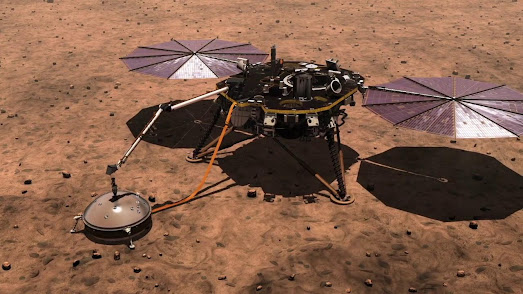On May 4, 2022, the Mars InSight Lander seismometer recorded a long-awaited “big one”. A marsquake measuring 5 on the Richter scale. The largest quake recorded on another planet, though far below the largest quakes recorded on planet Earth. The Mars InSight Lander seismometer is part of the Seismic Experiment for Interior Structure (SEIS) payload that was sent to Mars. Together with other mission instruments, SEIS is also the first Mars exploration instrument that was taken off the deck of the lander, and placed on the surface of Mars. Thus, the Martian seismometer has a dome, shielding it against heat, wind and dust on Mars. See the photo below of the InSight lander, showing deployment of the SEIS dome, on the Maritan surface, at the onset of the mission in 2018, and the (dustless) solar panels on each side of the lander.
InSight is an acronym for Interior Exploration using Seismic Investigations, Geodesy and Heat Transport. The mission’s robotic spacecraft, launched on May 5, 2018 from the Vandenberg Air Force Base, in California, on an Atlas V launch system, landed on November 26, 2018, at the Elysium Planitia site, straddling the Martian equator. The InSight spacecraft was launched with two CubeSats, called Mars Cube One or MarCOs. Briefcase-size satellites that went into orbit behind the Insight Space capsule, and that were designed to relay communication about the Insight spacecraft, upon entry, descent, and landing on the Martian surface.
The scientific purposes of the InSight mission were twofold: 1. Understanding the formation and evolution of Mars, and 2. Determining the level of tectonic activity on Mars. Thus, the InSight mission was the first mission designed to study the inner core of planet Mars, formed 4.5 billion years ago, and its vital signs: pulse (seismic activity), temperature (heat flow), and reflexes (precision tracking).
Using radio frequencies, the Rotation and Interior Structure Experiment (RISE) antennas were designed to track the exact position of the InSight lander on Mars. The RISE instruments reflected back the signal sent from Earth to the lander, thus also determining the exact position of Mars. In turn, tracking the position of Mars was designed to calculate how much the planet Mars wobbles, as it orbits the sun. A calculation intended to bring further insight into the composition and structure of the Mars core, particularly the question of whether the Mars core is solid or liquid.
The Heat Flow and Physical Properties Package (HP3) was designed to burrow, almost 16 feet deep into the surface of Mars, to measure heat flow, from the core to the surface of Mars. However, the instrument malfunctioned, due to the unanticipated differences in Martian soil properties, which prevented the tool from boring into the soil, to reach any depth.
Weather instruments, the Temperature and Winds for InSight (TWINS) suite, onboard the InSight lander, also relayed meteorological data from Mars (1).
The May 4th marsquake was recorded on the 1,222nd Martian day, or sol, of the InSight Lander mission. A mission scheduled to end in December 2022, due to dwindling power supply, unrenewed by the solar panels, now thickly covered with Martian soil dust. The Youtube video below shows a seismograph and sonification of the signals recorded on May 4th, on Mars, using the Mars Insight lander seismometer.
Note
(1) The SEIS and HP3 instruments were essentially provided by the European Space Agency, bringing together the French Aerospace Agency, (CNES), the Institut de Physique du Globe de l'Université de Paris (IPGP), the German Aerospace Center (DLR), the German Max Planck Institute for Solar System Research (MPS), the Swiss Federal Institute of Technology (ETH Zurich), as well as the Imperial College (in the UK) and the Space Research Center (CBK) of the Polish Academy of Sciences and Astronika. The RISE instruments were provided by NASA’s Jet Propulsion Lab (JPL).
NASA Insight Lander Mission
https://mars.nasa.gov/insight/
NASA’s Insight records monster quake on Mars
https://mars.nasa.gov/news/9185/nasas-insight-records-monster-quake-on-mars/
NASA Mars Insight Mission: The Instruments
https://mars.nasa.gov/insight/spacecraft/instruments/summary/
NASA Mars Insight Mission: The Instruments - RISE
https://mars.nasa.gov/insight/spacecraft/instruments/rise/
NASA NASA Mars Insight Mission: The Instruments – SEIS
https://mars.nasa.gov/insight/spacecraft/instruments/seis/
NASA Mars Insight Mission: The Instruments – HP
https://mars.nasa.gov/insight/spacecraft/instruments/hp3/
https://mars.nasa.gov/insight/weather/

No comments:
Post a Comment